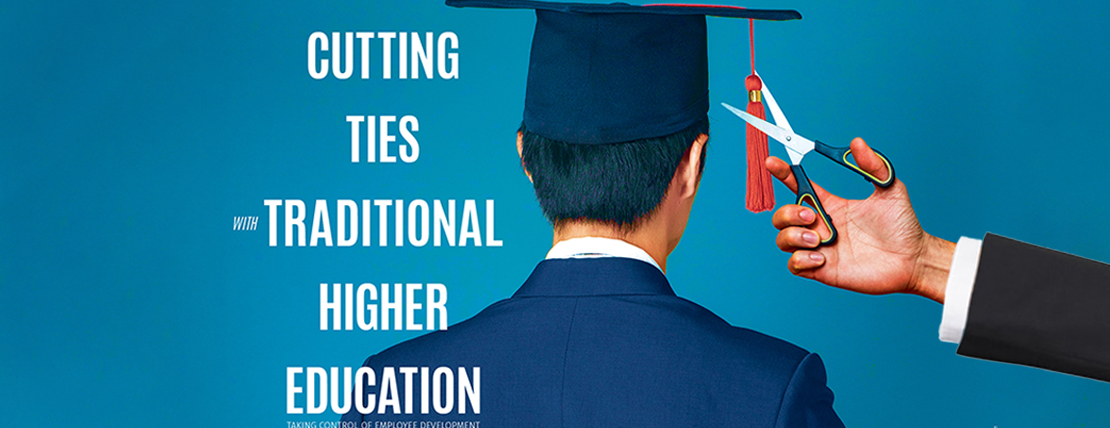This past summer, google announced an expanded suite of certificate training programs for it support,
user experience design, and project management.
The goal: thousands of people gaining skills for in-demand, well-paying entry-level jobs.
The prerequisites: none.
The cost: roughly $50 a month for six to eight months of study online.
A lot of people have bought in: According to Google spokesperson Andréa Willis, more than 300,000 people globally have enrolled in the IT support course alone since its launch in 2018. Google isn’t the first company to take education into its own hands. But the low cost and low barrier to entry — 61% of participants possess less than a college degree — have prompted observers to wonder: If Google can mint skilled workers like this, what do we need colleges for?
It’s a bit of a facetious question. But only a bit. As COVID-19 forced colleges to close campuses and move teaching online in 2020, many have questioned the value of higher education without an in-person experience, especially as college costs skyrocket. Last year, undergraduate college enrollments dipped 2.5% from 2019 levels, according to the National Student Clearing House. If the private sector has seized opportunities to train workers at good starting salaries as needs arise, and for a much lower cost, then the semester system at four- year colleges may no longer be an efficient way for industries to meet their needs.
Ryan Craig, managing director of Achieve Partners and University Ventures, which invests in credential- and certification-based workforce training programs, likens four-year degrees to a “macro credential” that’s retained social cachet at the best-known institutions, but is other- wise increasingly outdated in terms of today’s workplace challenges.
“With digital transformation, the workforce has accelerated far away from what traditional colleges and universities and our education ecosystem do in terms of skill development,” said Craig, author of A New U: Faster and Cheaper Alternatives to College.
Companies and higher-education institutions alike are working to close that gap. Though Google’s certificate program looks like a shot across the bow, higher education and other educational institutions still play a meaningful role in how employers find workers. Indeed, private industry and educational institutions have learned to be savvier about working together to address worker needs, and new models for education are emerging from it.
New training programs
In 2019, Boeing was looking to hire 450 electrical cable harness wirers in the next three years to work at its production facilities. And it needed them quickly. Rather than take on the task on its own, it brokered a partnership with Mesa (Ariz.) Community College (MCC). Boeing provided trainers, while the college provided the training facility and a credit structure around the course. Those who successfully completed the program received an industrywide certification and college credit.
To make it work, MCC needed to escape the traditional semester model, building a curriculum for a two-week boot camp that could enroll participants after a basic assessment, and at low cost: Tuition was just $225, and reimbursed to those who completed the program. The scale of what Boeing needed made a training partner important, said Leah Palmer, executive director of MCC’s Arizona Advanced Manufacturing Institute.
“A lot of times industry doesn’t knock on the door [of colleges] until they need help, because they have been used to a segmented pathway where people are being trained somewhere, then a company puts out a job description, people apply and then they sift for the highest-quality applicants,” she said. “But Boeing needed 450 people in a matter of two and a half years. From a pipeline standpoint, that’s astronomical.”
So far, the program has attracted 338 students, many of them college age or younger: 44% of participants are from 15 to 24. Moreover, 55% are first-generation college students. And though Boeing is looking to hire for its own needs, the certification is portable within the aerospace industry, and MCC has a new batch of potential students.
“We’ve been focusing on listening to exactly what our industry partners need rather than what we have to offer,” said Michael Voss, MCC’s Dean of Instruction — Career and Technical Education.
"...to move into management, you have to read a financial statement and
you have to be able to prepare and manage a budget.
Do you need an MBA for that?
The answer is no."
The Boeing-MCC partnership is a swifter, just-in-time-delivery version of the vocational training that’s been a hallmark of community colleges. But the new workforce environment has created opportunities for other mediators between employers and trainees, especially around certifications. For instance, Becker Professional Education, which has long specialized in CPA training, has recently expanded into areas, such as management accounting, that have been the traditional province of business schools.
Becker isn’t trying to replace business schools, but its certification focus emphasizes the increased interest in skills-focused training, and reflects growing dissatisfaction with the MBA model. According to a Bloomberg Businessweek survey conducted in 2020, 63% of students at top-tier MBA programs said the expense isn’t justified.
Ken Koskay, senior director of sales and business development at Becker, notes a recent growth in interest in the Certified Management Accountant credential, especially internationally, as global students skip American universities, be it related to COVID-19 or the tuition expense.
Regardless, training people to take the CMA exam fills a gap. “If you’re coming out of business school and undergrad with a general business degree, you’re likely not going to be as literate as you need to be to read a set of financial statements or to prepare a budget,” Koskay said. “And the reality is, in today’s world, if you’re going to move into management, you have to read a financial statement and you have to be able to prepare and manage a budget. Do you need an MBA for that? The answer is no.”
"Part of the reason you may not get the talent you want is how you’re listing your jobs. They’ll say a bachelor’s degree is required, but when you dig into the skills, they’re completed in two semesters."
An industry-education tug of war
The tricky part, though, is that many employers still look at college diplomas when it comes to hiring.
Voss said that his interactions with corporate partners involve moving away from the degree mind-set. “We’re re-educating the employers,” he said. “Part of the reason you may not get the talent you want is how you’re listing your jobs. They’ll say a bachelor’s degree is required, but when you dig into the skills, they’re completed in two semesters.”
And many families, especially those with first-time college students, have a hard time shaking the sense that a college degree is essential — a sense validated by company hiring practices. Employers still use a bachelor’s degree as a baseline, even as it becomes potentially less relevant to workforce needs, noted Brent Parton, deputy director of the Center on Education and Labor at New America, a Washington, D.C. think tank.
“There’s been an ongoing tension between education and industry,” Parton said. “Industry says, ‘Education is not delivering the skills and competencies we need for our rapidly changing jobs.’ And education says, ‘That’s not our job. We can’t stay abreast of changing technology and changing work processes of industry. We have to educate a lot of people for a lot of different things.’ So it’s been a tug-of-war about whose job it is to prepare the workforce and how.”
New America’s attempt to square that circle is the Partnership to Advance Youth Apprenticeship (PAYA), a three-year program launched in 2018 that connects high school students with apprentice opportunities managed by community organizations and employers. Such apprenticeships are common in vocational trades, but PAYA’s partners include companies in health care, technology and finance, as well as manufacturing. High- school students get work experience and college credit; employers get early entrants into the workforce pipeline.
To date, PAYA has connected 2,000 apprentices with 600 employers in 13 industries. Whether the program can successfully scale, Parton says, will depend on employers seeing benefits from engagement that’s more long-term than conventional internships.
“You have to discuss it as a return-on-investment strategy,” he said. “People will say, ‘Why would I [support] an apprenticeship, which could last between two to four years, versus an internship that’s three months?’ The difference is that the length of that person’s working for your company and contributing to your culture is actually core to how much productivity you get out of that person.”
Growing gaps
Another limiting factor may simply be the size of investment companies can make in training outside of higher education. In 2019, for instance, Amazon launched Upskilling 2025, a $700 million program to provide 100,000 members of its work- force training opportunities on machine learning, software engineering, IT support and other technical fields.
In the case of Google’s certificate program, the company has enough clout to have built a consortium of more than 50 companies that have pledged to consider those who’ve completed the program for entry-level roles. The goal, Willis said, isn’t strictly for its workforce. “While Google considers graduates for entry-level roles, it created the program to help graduates secure jobs across industries — not as a hiring pipeline for Google specifically.”
Craig is skeptical, though, whether such ventures are helping to satisfy a genuine workforce demand or are effectively PR initiatives. Companies such as Google, Microsoft and other technology companies “are much more focused on gaining acceptance for their products than they are on training their future employees. The No. 1 constraint on their growth in many countries is access to trained talent for their prospective clients. So [training] becomes a sales tool.”
And for industries with legitimate gaps to fill, neither the higher-education system nor the companies themselves have clear ways to fill them. For instance, companies increasingly need employees with experience on Salesforce’s customer relationship management software, but Salesforce itself has only made modest investments in training, and four-year colleges may consider such training too niche for their curricula. Who’s filling the gap?
“No one,” Craig said. “That’s why we have 300,000 open Salesforce jobs.”
The ability to provide that kind of niche training on the fly is something to which community colleges are well-suited, said Voss. Community colleges in general have been creating ways to “crosswalk” private-industry certificates and credentials; that is, qualify them for college credit.
“We’re in the process of crosswalking every known industry credential that impacts our work,” he said. MCC plans to reach out to state residents who have relevant credentials and encourage them to enroll. “We want to send a message that we’re open for business to give you credit at no cost, and we want to help you with the next step.”
If educational institutions can demonstrate the necessary flexibility, as MCC did with its Boeing partnership, and industry can see the value in credentials outside of BAs and other college degrees, some of the skills gaps may start closing. In both cases, Craig said, they’d be catching on to a trend that benefits them both.
“We need to shift right now,” he said. “We live in a world of macro credentials — degrees that have high social-signal strength but low skill-signal strength. We’re seeing a shift to micro credentials with low social-signal strength but high skill-signal strength. It’s going to be bad news for most colleges and universities that just simply don’t have the capacity to make that conversion. They don’t have a very good interface with the world of work.”
"We’re seeing a shift to micro credentials with low social signal strength but high-skill signal strength."







